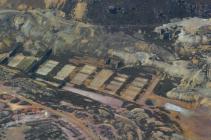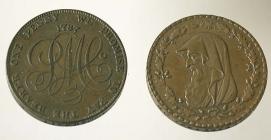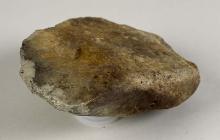Parys Mountain, Amlwch
Items in this story:
Parys Mountain, Amlwch
The Mona and Parys copper mines were situated on Parys Mountain, which is around two miles south of Amlwch on Anglesey. The area's original name was Mynydd Trysglwyn. It was renamed Parys Mountain after Robert Parys, who received the land as a prize from the king in 1406 for collecting taxes and fines from the inhabitants of Anglesey for their support of Owain Glyndŵr.
The land was passed down the generations for the next 300 years. In the middle of the eighteenth century, the land belonged to the Bayley family from Plas Newydd and William Lewis from Llys Dulas, the two biggest landowners on Anglesey. The land was mostly used to graze sheep.
There began a search for new sources of copper during the 1760s, when the British Navy began to ensure that timber ships were copper-bottomed. In 1761 remains of earlier mining were discovered on Parys Mountain when the Meirionethshire Archdeacon's horse fell into a shaft. A number of shafts were dug, the “Old Works”, and copper was discovered, but flooding hindered the mining work.
A big discovery
On 2 March 1768 a rich seam was found on Parys Mountain , and the finder, Rowland Puw, a local miner, was awarded a bottle of whisky and a rent-free cottage for life! After this discovery it was realised how rich in ore Parys Mountain was. The boundary was between Cerrig y Bleddia's land, owned by the Bayley family of Plas Newydd, and Fferm Parys farm, which was owned by the Hughes family of Llys Dulas, through a marriage. Thomas Williams (Twm Chwarae Teg), a local lawyer, became a spokesman on behalf of the Hughes family, and with his help the Parys Mine Company was formed (the Hughes and Williams Partnership) in 1774, with Jonathan Roose as technical consultant. Over the years that followed, offices, storehouses, kilns and smelting furnaces were built either on the mountain or in the port of Amlwch. By 1786, there were 31 smelting furnaces and a 41 foot high chimney in the port!
In 1784 Thomas Williams won the contract to supply the bolts and planks used by the Navy to protect ships from sea worms. The first contract was for 25,000 bolts per week, but that amount grew to 40,000 per week! Between 1788 and 1805, around three million tons of ore was mined, enough to produce 130,000 tons of copper.
Anglesey Penny
Pennies were rare in 1786/1787 as the royal mint had ceased their production. In 1775, Thomas Williams decided that there was a need for pennies, and in 1787 the first were produced, copper pennies, with a depiction of a druid surrounded by oak leaves, with the letters 'PMC', standing for Parys Mining Company on the reverse. They also included the words 'We Promise to pay the bearer one penny' (see the above image). This was to remind people that they were trade tokens and not the kingdom's official coinage. The miners were then paid with these tokens. Thomas Williams then went on to found the Amlwch Shipping Company in 1788. He died in 1802.
By 1811, the Earl of Uxbridge (the son of Nicholas Bayley, Plas Newydd) was the owner, and he formed a new company with the Vivian family from Swansea, who owned many of the copper works in Swansea and Cornwall. The family introduced a Cornishman, Vivian James Treweek, to Parys Mountain, and he eventually became the works' manager. He began sinking deep shafts, as in Cornwall, which was completely different to the opencast mining which had happened up until then on Parys Mountain. Some of these shafts extended around 350 metres. He was so successful that by 1816 the mines' output had risen sixfold.
James Treweek was used to pumping water from mines, and in 1819 Pearl machine house was built to keep the mines dry. It was opened in 1819, and today this is the only example of a Cornish beam engine in Wales. James Treweek was manager of the copper works until his death in 1851.
The decline of the copper industry
The call for copper had diminished at the beginning of the 19th century, and the mines were finding it more difficult to make a profit. In 1829, 16,400 tons of copper was being mined annually, only half the amount that was mined at its peak. A new copper seam was discovered in the 1850s, and this was a short term boost for the area, but from 1878 on it became to expensive and difficult to extract the copper. By the census of 1901, there were only 141 workers at the mines, and by 1904 the underground work had come to an end.
In 1937 archaeological excavations were made in the area, and 24 items were discovered. The area was excavated again in 1988 and more items were found. The charcoal seam was carbon dated to between 2050 and 1690 BC, which suggests that there was mining in the area during the Bronze Age.
In July 1995, a team studied the area's underground workings. Most of the workings dated from the 18th and 19th century, but a chamber was discovered around twenty metres beneath the surface which was more than likely prehistoric. In 2001, Parys Underground Group decided to explore the area once again, and there were anxieties when a dam was found which was built to stop the workings from flooding. With the support of Amlwch Industrial Trust, Anglesey Mining PLC, Wales Development Authority, Countryside Council for Wales and the local council, the Dewatering Project was begun in 2003. Around 30 million gallons of water was removed in total.



